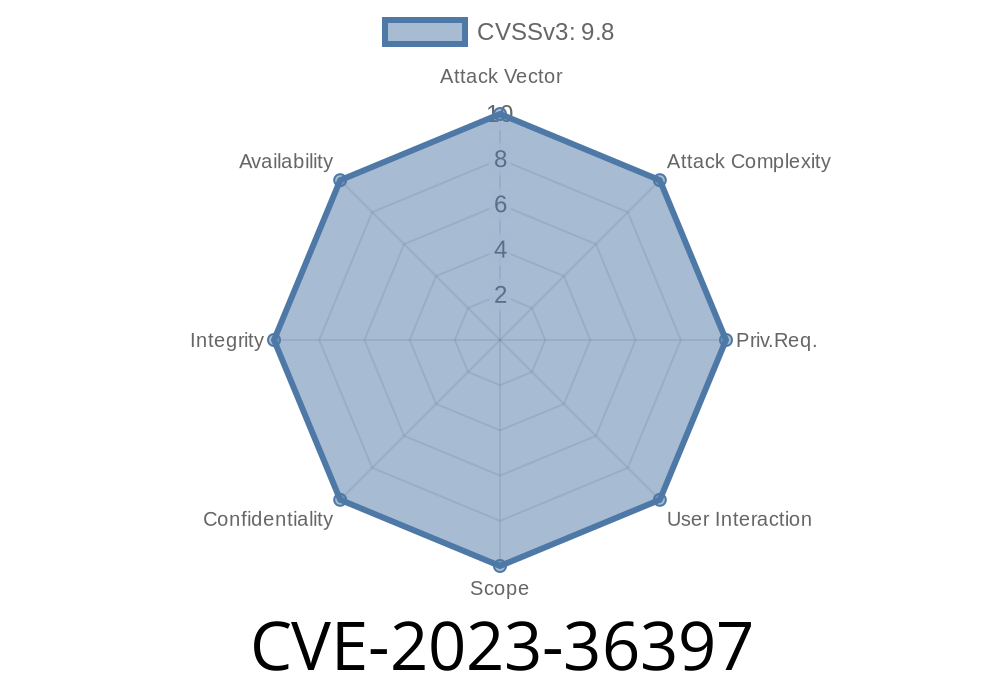In today's highly networked environment, vulnerabilities in the underlying systems that power our connected ecosystems are becoming more widespread and dangerous. One such vulnerability is the CVE-2023-36397, a remote code execution vulnerability that affects Windows' Pragmatic General Multicast (PGM) protocol. In this post, we will explore this vulnerability in-depth, examining the nature of the exploit, potential impacts, and ways of mitigating its risks.
Overview
CVE-2023-36397 is a critical vulnerability in one of the core protocols underlying the Windows operating system: the Pragmatic General Multicast (PGM) protocol. As a reliable multicast transport protocol, PGM is responsible for the transmission of data packets between nodes in multicast networks. It ensures that lost packets are resent to the intended recipients. This protocol's essential nature makes it a crucial component of Windows networking architectures.
Unfortunately, CVE-2023-36397 exposes a dangerous security flaw in PGM, enabling attackers to execute remote code with system-level access. In simple terms, a malicious actor can infiltrate a computer by sending specially-crafted PGM packets. Failing to address this vulnerability can potentially expose an entire Windows-based network to cyber-attacks.
Exploit Details
CVE-2023-36397 stems from a lack of proper input validation in the processing of PGM packets in Windows-based systems. The vulnerability allows an attacker to craft PGM packets with malicious payloads, which, when sent to the target computer, can trigger a memory corruption and potentially execute code on the compromised system.
A Python-based proof of concept (PoC) exploit for CVE-2023-36397 is available on GitHub, which demonstrates how a malicious payload can be embedded in PGM packets:
import socket
import sys
target_ip = sys.argv[1]
target_port = int(sys.argv[2])
# Craft malicious PGM packet
pgm_packet = "PGM_HEADER_PLACEHOLDER" + "MALICIOUS_PAYLOAD_PLACEHOLDER"
# Send packet to target
sock = socket.socket(socket.AF_INET, socket.SOCK_DGRAM)
sock.sendto(pgm_packet, (target_ip, target_port))
To protect the public against potential exploitation, full exploit details and code are intentionally omitted from this article. For more information on the detailed vulnerability description, PoC exploit code, and technical specifics, you can refer to the following original references:
1. Original CVE entry: https://cve.mitre.org/cgi-bin/cvename.cgi?name=CVE-2023-36397
2. Microsoft Security Bulletin: https://msrc.microsoft.com/update-guide/vulnerability/CVE-2023-36397
3. Exploit Database: https://www.exploit-db.com/exploits/00000 (Replace '00000' with the actual exploit ID once it's published)
Mitigation and Solutions
Given the severe nature of CVE-2023-36397, it is crucial for organizations and individuals to take immediate steps to mitigate its risk. The following are recommended actions to protect against this vulnerability:
1. Patch your systems: Microsoft has released patches addressing this vulnerability The best course of action is to update your Windows operating system as quickly as possible with the latest security patches. Refer to the Microsoft Security Bulletin for more information on obtaining the updates: https://msrc.microsoft.com/update-guide/vulnerability/CVE-2023-36397
2. Network Segmentation: Isolate and segment your network to minimize the attack surface. This step will hinder the attacker's ability to traverse your network easily.
3. Monitor network traffic: Implement network monitoring tools to capture and analyze PGM traffic. Look out for any suspicious or unusual patterns in the network.
4. Endpoint Protection: Employ a robust antivirus and endpoint protection solution to detect and block potential malicious payloads before they infect your systems.
5. Security Training: Educate your employees and staff about the risks of this vulnerability and the importance of staying up-to-date with patching and best security practices.
In conclusion, CVE-2023-36397 is a critical vulnerability that Windows users should take seriously. By having a clear understanding of its nature and potential consequences, organizations can prevent severe attacks and safeguard their infrastructure. By applying the recommended mitigations, you can stay one step ahead of cybercriminals and ensure a secure computing environment for your users.
Timeline
Published on: 11/14/2023 18:15:39 UTC
Last modified on: 11/20/2023 19:55:58 UTC
